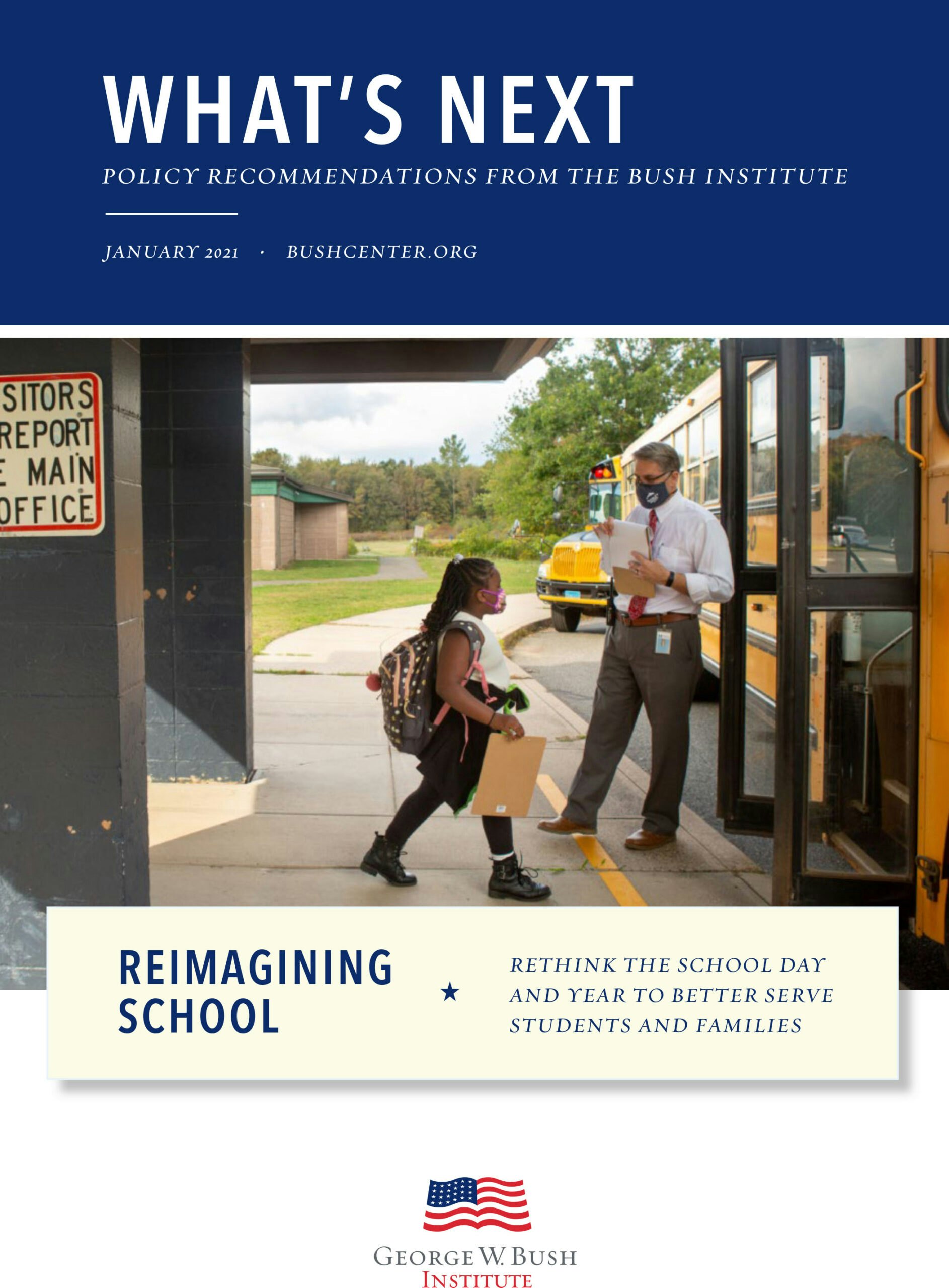Our Recommendations:
- The education community needs to better understand the needs of families
- States should make more flexible scheduling possible
- Schools should rethink their roles in communities
- Funding streams can be used to support innovative school schedules
With everything the pandemic is showing us in terms of new school models, it’s an opportune time to rethink and reimagine what could be.
Despite warnings that the school schedule that has been around for more than 100 years is not optimal for serving students’ needs, little has changed. The needs of kids and families look very different today than they did 50 years ago. One-size-fits-all prescriptions do not meet the needs of a diverse student population. Rethinking the school schedule could address these issues. This can be accomplished by proactively surveying parents to understand who schools are serving and what their specific needs are, examining state laws and regulations that sometimes make more flexible scheduling impossible, reimagining how time is used within the hours that kids are in school, and using existing funding streams, such as Title I, to support innovative school schedules.
COVID-19 is laying bare two realities in education: Schools are not making the most of the time they have with students, and the school calendar is not friendly to working families. We have been warned about these issues for several decades, but the pandemic has brought them to the forefront in a way that we would not have seen in an otherwise regular school year. This is the moment to imagine and move toward a new vision of school that rethinks how schools use time.
School calendars across the country average out to approximately 180 days per year and between six and a half and seven hours of school per day. Most school schedules provide long summer breaks, to the point that it has become a cultural norm. The tourism and summer camp industries flex their muscles to keep it that way as well.
In 1983, when A Nation at Risk: The Imperative for Educational Reform was released, researchers questioned instructional time in American schools compared with other countries. The report recommended districts look at modifying their traditional school schedules to increase student achievement. Thirty-eight years later, there is little to show for it.
Meanwhile, our students are lagging academically. According to the Nation’s Report Card, only 35% of fourth graders were proficient in reading and only 41% were proficient in math on the 2019 assessment, and achievement gaps remain. Kids not on grade level often need more instructional time. And kids often lose ground academically over the summer — often referred to as the “summer slide” — which is an even more significant issue right now because of the pandemic’s effect on school schedules.
Low-income families bear the brunt of this challenge. When students are behind, higher-income families fill the gaps with tutors and additional classes after school and during the summer. They can also provide other extracurricular activities that support their kids’ growth and development, such as music, sports, summer camps, and enrichment opportunities.
This pandemic is also showing how the school schedule puts families in a bind. We often think of school in the context of its role in supporting kids academically and socially, but school is also childcare. Disruptions to the schedule this year because of COVID-19 have made that abundantly clear. A family with a parent who stays at home and does not work can more easily accommodate kids learning from home at least some of the time. Families with a parent working remotely at home have a harder time but can find ways to manage. But families with a single parent or two parents who work and cannot do so remotely are in a tough spot.
The pandemic is exacerbating this lack of alignment between the school schedule and the needs of kids and families, which have changed significantly over time. More parents — especially moms — are working. Today, 72% of moms of school-age children are employed, compared with about 50% in 1968, and 80% of working moms are employed full time. Nearly 90% of dads with school-age children are employed full time, according to a Pew Research report. So when school ends at 3 p.m., working parents face a practical challenge of what to do with their kids while they are still working.
While different school districts have tweaked the schedule over the years, those changes have been fairly minor. The revisions to the school day or year that have occurred have been driven by the school community, not the needs of kids and families. There is little information about the needs of parents and what would be helpful to them.
It’s time that changed. Rethinking time in school to better meet the needs of kids and parents aligns with principles that we should all view as important. One-size-fits-all prescriptions do not meet the needs of a diverse student population.
The education community needs to better understand the needs of families
As a starting point, states, districts, and charter-management organizations should proactively survey parents to understand who they are serving and what their specific needs are. Little information is available about the real needs of working parents as they relate to school schedules.
States should make more flexible scheduling possible
State officials should look at their laws and regulations regarding the school year. School year calendars are sometimes restricted to particular start dates, which can make more flexible scheduling impossible.
We need to reimagine how time is used within the six and a half to seven hours that kids are in school. That could mean different formulations than the traditional classroom, with some hybrid of direct instruction by the teacher and some work online during the school day. This would also allow kids to work at their own pace, moving toward a competency-based system of learning rather than the traditional seat-time model. Kids could take more time in the areas they need it and move to advanced coursework when appropriate.
Schools can also rethink how they can become hubs of service in the community. That means bringing more after-school and enrichment activities into the school building itself, even if those services are provided by other organizations. We can also think about using school buildings for other uses and longer periods of time in the school day and year, instead of letting them sit idle for hours and months, especially during the summer.
Schools should rethink their roles in communities
Schools can also rethink how they can become hubs of service in the community. That means bringing more after-school and enrichment activities into the school building itself, even if those services are provided by other organizations. We can also think about using school buildings for other uses and longer periods of time in the school day and year, instead of letting them sit idle for hours and months, especially during the summer.
Funding streams can be used to support innovative school schedules
As state leaders identify innovative models for using school time, they can use existing funding streams to support innovative school schedules. Title I, Part A dollars from the Elementary and Secondary Education Act and 21st Century Community Learning Center funding can be used for these purposes. Partnerships with local nonprofit organizations to co-locate existing services in schools should be explored more fully as a way to make extended-day programs available without adding significant new costs.
These changes could go a long way to better meet the needs of kids, especially low-income children, and those of working parents. With everything the pandemic is showing us in terms of new school models, it’s an opportune time to rethink and reimagine what could be. Big structural changes like this will be difficult and won’t happen overnight. But we also shouldn’t accept that the way we’ve been doing it for the past hundred years is getting us where we need to be as a nation.
These changes could go a long way to better meet the needs of kids, especially low income children, and those of working parents. With everything the pandemic is showing us in terms of new school models, it’s an opportune time to rethink and reimagine what
could be. Big structural changes like this will be difficult and won’t happen overnight. But we also shouldn’t accept that the way we’ve been doing it for the past hundred years is getting us where we need to be as a Nation.





























